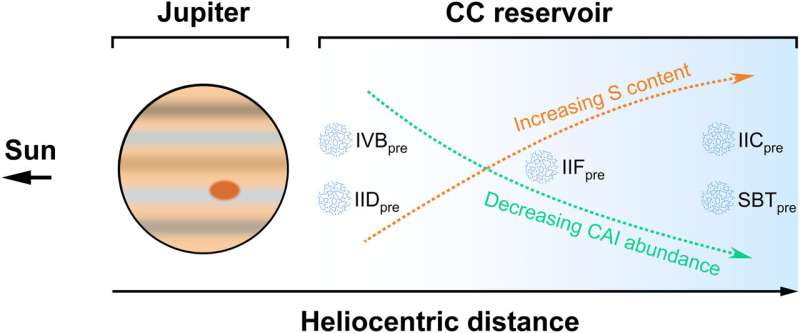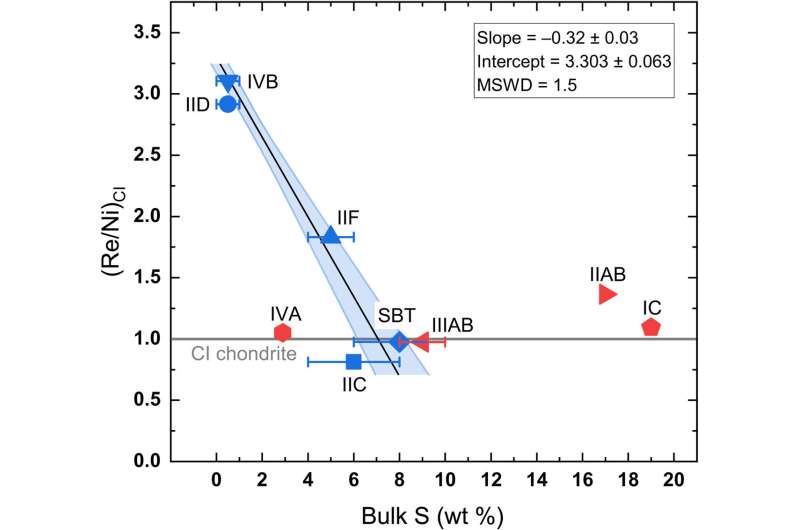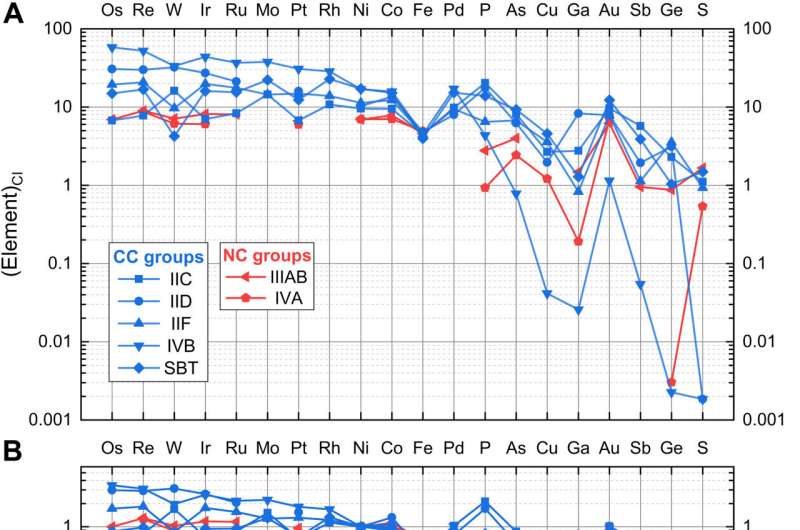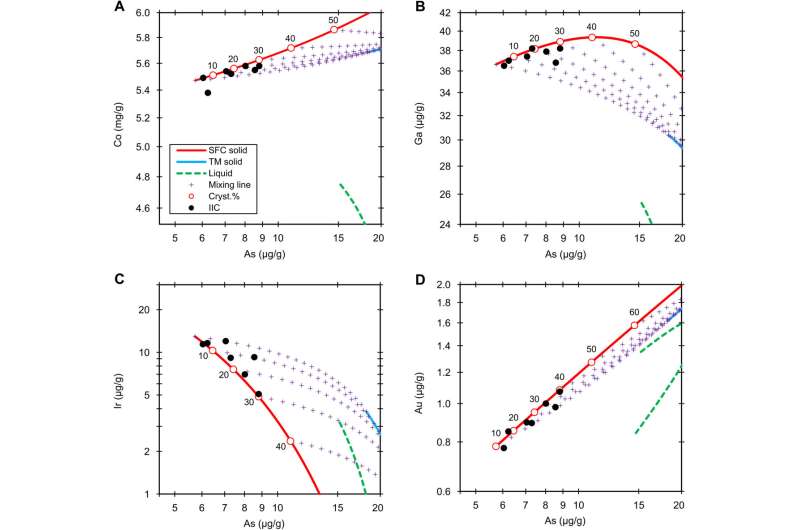September 29, 2022 feature
The composition of asteroidal cores in the early solar system

Iron meteorites of the solar system are composed of parent cores belonging to the earliest credited bodies of the environment. The cores are formed in two isotopically distinct reservoirs including non-carbonaceous and carbonaceous types in the inner and outer solar system. In a new report now published in Science Advances, Bidong Zhang and a team of scientists in Earth, Planetary and Space Sciences, at the University of California Los Angeles, and the Applied Physics Laboratory of Johns Hopkins University, measured the elemental composition of carbonaceous-iron groups using fractional crystallization modeling to reconstruct bulk compositions and crystallization processes of preceding parent asteroid cores.
The results showed lower sulfur and higher phosphorous in carbonaceous iron cores compared to non-carbonaceous cores. The team linked the diverse elemental abundance among carbonaceous cores to the distribution of calcium aluminum rich inclusions in the protoplanetary disk, which may have been transported to the outer solar system and heterogeneously distributed in the first million years of the history of the solar system.
Understanding the asteroidal composition of the early solar system
Astrophysicists classify most meteorites into two categories; the carbonaceous (abbreviated CC) and non-carbonaceous (abbreviated NC) types that rely on nitrogen, oxygen, titanium, nickel, tungsten, molybdenum and ruthenium compositions. The isotopic dichotomy is revealed via nucleosynthetic anomalies that show how carbonaceous meteorites are enriched in rapid neutron capture process nuclides, compared to non-carbonaceous meteorites. A majority of meteorites appear to originate either from the inner solar system (non-carbonaceous) or the outer solar system (carbonaceous). Researchers assume the two reservoirs were likely separated by the formation of Jupiter more than 1 million years ago, after the formation of calcium aluminum-rich inclusions (CAIs).
Iron meteorites can be further categorized into magmatic and nonmagmatic features, where the former was formed by fractional crystallization in well mixed molten metallic cores within differentiated asteroids. The chemical signatures and planetary evolutionary histories of asteroidal cores can be reconstructed by fractional crystallization modeling. Existing models of crystallization for CC iron groups and NC were primarily based on ruthenium, germanium, palladium, iridium, osmium or gold elements.
In this work, Zhang and colleagues used new, high-precision neutron activation analysis data supplemented with inductively coupled plasma mass spectrometry data. They presented the outcomes for 19 elements, and estimated the composition of carbonaceous-iron cores and non-carbonaceous cores, to understand the processes responsible to fractionate siderophile elements among the cores and reconstruct crystallization processes of the CC-iron cores.

Fractional crystallization approach
Researchers can typically model variations in the concentrations of siderophile elements of a magmatic iron meteorite group via fractional crystallization. For instance, increasing sulfur and phosphorous concentrations in metallic melts can impact the behavior of siderophiles. Furthermore, although the phosphorous concentrations were accurately measured in most iron meteorites, the presence of sulfur cannot be directly determined. Zhang and the team generated a new model to determine an initial bulk composition with sulfur and phosphorous to fit most of the 18 interelement trends of interest. The strategy worked well for a range of elements and led to the development of several elemental classifications in the work.

Highly siderophile elements (HSE) and refractory metal nuggets (RME)
The researchers showed how the elevated bulk concentrations of highly siderophile elements (HSE) in a core were either due to the redox state of the parent body or a mixture of different abundances of high-temperature refractory metals from the solar nebula. With carbonaceous chondrites, the researchers observed the highly siderophile elements to be enriched in calcium-aluminum rich inclusions, compared with other silicate-rich components and refractory metal nuggets, which contributed to form the primary hosts for the highly siderophile elements.
The work further explored the siderophile elements and the sulfur/phosphorous abundance to support the idea that sulfur contents may have a significant influence on the differentiation temperature of the iron meteorite parent bodies. They examined the fractionation of volatile and moderately volatile siderophiles as well as the crystallization processes to understand the origin of the CC- and NCC iron cores. The team estimated the evolution model of the solar protoplanetary disk and the HSE abundances of the carbonaceous iron cores using fractional crystallization models to suggest the formation of HSE-enriched asteroids closer to Jupiter in the pressure bump, while HSE-chondritic asteroids formed further away from Jupiter.

Outlook: Asteroidal composition of the first few million years of the solar system
In this way, Bidong Zhang and colleagues described the bulk compositions and crystallization processes that occurred in the first few million years of the solar system's history to create carbonaceous type iron meteorite cores, which led to the evolution of metallic melts and asteroidal cores. They conducted fractional crystallization modeling to reconstruct the bulk composition and crystallization processes of interelement trends across carbonaceous type iron meteorite groups.
The outcomes showed the composition of the carbonaceous (CC) iron group and non-carbonaceous (NC) iron groups to demonstrate their contribution to crystallization and compositional evolution. While CC-iron cores crystallized in oxidized environments when compared to NC cores, they had lower sulfur contents, higher phosphorous, nickel and increases of highly siderophile elements in their parent melts, when compared with NC-iron cores.
More information: Bidong Zhang et al, Compositions of carbonaceous-type asteroidal cores in the early solar system, Science Advances (2022). DOI: 10.1126/sciadv.abo5781
Damanveer S. Grewal et al, A very early origin of isotopically distinct nitrogen in inner Solar System protoplanets, Nature Astronomy (2021). DOI: 10.1038/s41550-020-01283-y
Journal information: Nature Astronomy , Science Advances
© 2022 Science X Network





















